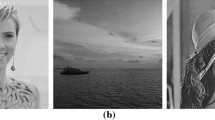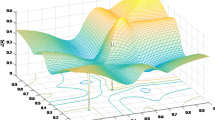Abstract
The nonnegative blind source separation (NBSS) algorithm based on minimum volume simplex (MVS) criterion is excessively dependent on the shape of the mixture scatterplot, resulting in the situation in which the MVS-based algorithm may have no solution. In this paper, we propose a new noiseless NBSS model and introduce edge features into high-order determined NBSS. The edge feature-based NBSS model can compensate for the shortcomings of the MVS-based algorithm. The twice projections (TP) algorithm is designed to replace the existing clustering and regression algorithms; moreover, TP prevents the aliasing phenomenon caused by direct projection and effectively reduces the time complexity of dimension reduction. We search for the coordinates of the density maximum points in 2-D space, and gradually merge them into high-dimensional coordinates, which greatly reduces the complexity of the algorithm. Furthermore, we only make boundedness and nonnegativity assumptions about the source, which makes the algorithm more widely applicable.














Similar content being viewed by others
Availability of data and material
All of the material is owned by the authors, and/or no permissions are required.
References
Chen, M.S., Han, J., Yu, P.S.: Data mining: an overview from a database perspective. IEEE Trans. Knowl. Data Eng. 8(6), 866–883 (1996)
Craig, M.D.: Minimum-volume transforms for remotely sensed data. IEEE Trans. Geosci. Remote Sens. 32(3), 542–552 (1994)
Dermagne, L.J., Gauthier, P.A., Berry, A.: Ambisonics and blind source separation in virtual acoustics: sound field reproduction of separated sources. J. Acoust. Soc. Am. 148(4), 2794–2794 (2020)
Gong, T., Zhang, Z., Luo, X., Li, Y.: Quantitative identification of independent and dependent sources based on bounded component analysis. Meas. Sci. Technol. 32(3), 035009 (2020)
Hyvärinen, A., Hurri, J., Hoyer, P.O.: Independent component analysis. In: Natural Image Statistics, pp. 151–175. Springer (2009)
Jiang, D., He, Z., Lin, Y., Chen, Y., Xu, L.: An improved unsupervised single-channel speech separation algorithm for processing speech sensor signals. Wirel. Commun. Mob. Comput. 2021, 1–13 (2021)
Li, J., Bioucas-Dias, J.M.: Minimum volume simplex analysis: A fast algorithm to unmix hyperspectral data. In: IGARSS 2008-2008 IEEE International Geoscience and Remote Sensing Symposium, vol. 3, pp. III–250. IEEE (2008)
Miao, L., Qi, H.: Endmember extraction from highly mixed data using minimum volume constrained nonnegative matrix factorization. IEEE Trans. Geosci. Remote Sens. 45(3), 765–777 (2007)
Parathai, P.: Blind source separation using statistical nonnegative matrix factorization. Ph.D. thesis, Newcastle University (2015)
Puntonet, C.G., Prieto, A.: Neural net approach for blind separation of sources based on geometric properties. Neurocomputing 18(1–3), 141–164 (1998)
Senay, S.: Time-frequency BSS of biosignals. Healthc. Technol. Lett. 5(6), 242–246 (2018)
Silva, M., Martinez, B., Figueiredo, E., Costa, J.C., Yang, Y., Mascareñas, D.: Nonnegative matrix factorization-based blind source separation for full-field and high-resolution modal identification from video. J. Sound Vib. 487, 115586 (2020)
Wang, Y., Huang, W., Zhang, Q., Wei, D.: A fast identification method of shortwave radio stations based on sparse component analysis. In: 2021 28th International Conference on Telecommunications (ICT), pp. 1–6. IEEE (2021)
Wang M, Z.W.: Bss algorithm based on apso application in image processing. In: Video Engineering, pp. 151–175 (2014)
Xu, X., Li, J., Li, S., Plaza, A.: Generalized morphological component analysis for hyperspectral unmixing. IEEE Trans. Geosci. Remote Sens. 58(4), 2817–2832 (2019)
Zhao, M., Wang, Z., Zhao, Z., Dong, Z., Zhang, Z.: The algorithm for nonnegative blind source separation using edge feature. SIViP 16(4), 897–904 (2022)
Acknowledgements
This work is supported by the Scientific and Technological Innovation Foundation of Shunde Graduate School, USTB.
Funding
This work is supported by the Scientific and Technological Innovation Foundation of Shunde Graduate School, USTB.
Author information
Authors and Affiliations
Contributions
MingZhan wrote the main manuscript text, Xiaojun was in charge of the paper review, Weipeng was in charge of the paper layout, and other authors discussed and participated in the experiments.
Corresponding author
Ethics declarations
Conflict of interest
I declare that the authors have no competing interests as defined by Springer, or other interests that might be perceived to influence the results and/or discussion reported in this paper. The results/data/figures in this manuscript have not been published elsewhere, nor are they under consideration (from you or one of your Contributing Authors) by another publisher.
Ethical approval
This study did not involve human/animal research and is in compliance with national and international regulations.
Additional information
Publisher's Note
Springer Nature remains neutral with regard to jurisdictional claims in published maps and institutional affiliations.
Rights and permissions
Springer Nature or its licensor (e.g. a society or other partner) holds exclusive rights to this article under a publishing agreement with the author(s) or other rightsholder(s); author self-archiving of the accepted manuscript version of this article is solely governed by the terms of such publishing agreement and applicable law.
About this article
Cite this article
Zhao, M., Zheng, W., Lv, Y. et al. High-order nonnegative blind source separation based on edge features. SIViP 17, 4163–4170 (2023). https://doi.org/10.1007/s11760-023-02648-2
Received:
Revised:
Accepted:
Published:
Issue Date:
DOI: https://doi.org/10.1007/s11760-023-02648-2




